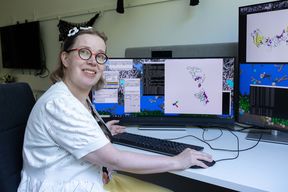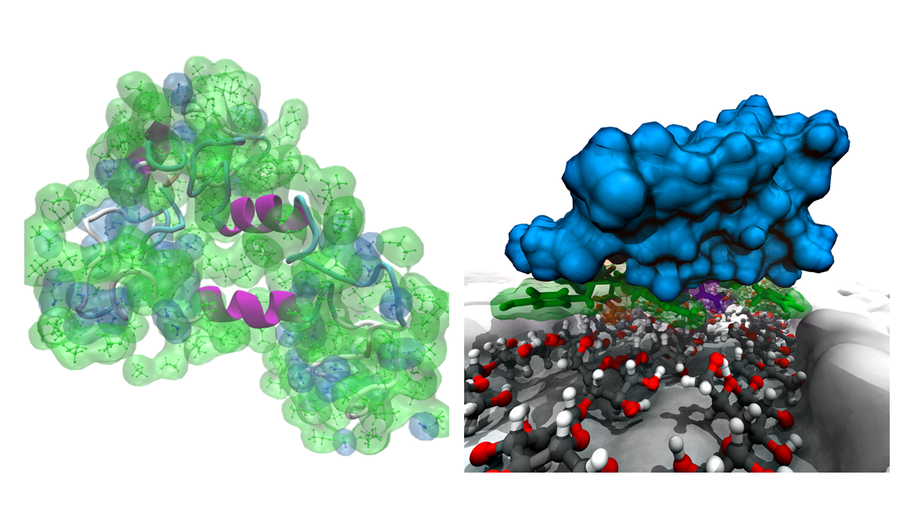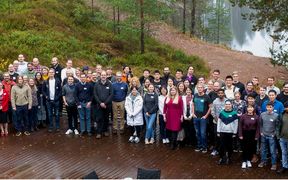Get to know us: Associate Professor Maria Sammalkorpi

How did you end up as a researcher?
Already as a child, I was focused and persistent: if I was interested in something, I would find out how it worked. I read a lot. My personality is suited for research work, and I have always enjoyed working as a researcher.
In my school days, I was interested in all subjects, but physics was both the most challenging and the most fascinating school subject for me. Physics explained mechanisms and understanding of how the world works, and it enabled the many technical devices around me. I also really liked the other natural sciences. After high school, I studied engineering physics at the Helsinki University of Technology. After completing two years of my studies, I got a research assistant position in the university, and since then I have been doing research work.
After my M.Sc. degree, I continued directly with doctoral studies. I knew that after doctorate, continuing my research career abroad would be a good idea. A bit before I completed my doctorate, my spouse got the chance to move to the United States for work, and I did post-doctoral research in the United States in City College of New York, Princeton, and Yale. My doctoral dissertation was computational modelling of carbon nanostructures, but I ended up expanding my research first to modelling of biological molecular systems, and later to colloidal and polymeric materials using different methods. Thinking back in time, I have concluded that if my spouse’s work had not tied us to a specific region in the US, I would not have had to learn how to repeatedly move to new research subjects. This has turned out to be a very useful skill later. I would have also missed learning many other things. Eventually, we had to make a decision whether to stay in the US permanently, which would have meant me accepting the professorship offered there. However, after some consideration, we decided to return to Finland. My return was made possible by a 5-year Academy of Finland Research Fellow appointment. I established my own independent research group in the Department of Chemistry at Aalto University, now the Department of Chemistry and Materials Science.
What do you research and why?
I am a professor of soft matter modelling at the Department of Chemistry and Materials Science at Aalto University. Soft matter covers bio-based and biological materials but more generally solutions, polymeric materials, and various colloidal materials, such as foams and emulsions. My research is computational modelling and theory study of these materials.
Soft materials are central to sustainable development, as all bio-based renewable materials are soft materials. In addition to this, softness allows for a wide range of new properties in materials. Soft matter is particularly interesting because it changes its shape and structure. These changes can be used to control the properties of the material. This can be used to create materials that respond to stimuli, such as light-controlled robotic materials or coatings that respond to temperature or humidity. For example, the Academy of Finland Centre of Excellence in Life-Inspired Hybrid Materials LIBER, in which I lead the modelling group, focuses on such materials. Another research direction that interests me particularly at the moment is the development of biosynthetic protein materials. For that, I have been awarded Ascending Investigator grant from the Novo Nordisk Foundation. Both grants are highly competitive, long-term grants that allow me to focus on the ambitious projects.
Computer modelling creates a prediction of the behavior of the material, a generalization of the observations through the simplification provided by the model, and an interpretation of the measured changes. Modelling is efficient and cost-effective, but also saves resources. Savings arise because not everything needs to be implemented and tested as actual samples, but the implementations can focus on the more promising directions. Essential uses for modelling in materials research are screening alternatives, identifying promising trends, and revealing operational mechanisms.
It is essential that my computational research has experimental research around it – modelling generated predictions and interpretation alone will not advance materials development.
How did you end up switching from physics to chemistry?
There is a very common misunderstanding in this question. I studied materials physics and various computational methods in physics. During my research career, my expertise has expanded for example, to some areas of chemistry and bio sciences. In my research, I use this foundation to solve current and timely materials-oriented research problems in soft matter in fields covering bio sciences and biotechnology, chemistry and materials science, and still also physics. Soft matter is studied in physics, chemistry, materials science, and in bio sciences, and it is inherently interdisciplinary - drawing boundaries between different disciplines is not fruitful in this context. A good example is our center of excellence LIBER, in which the researchers have very different study backgrounds.
What do you consider important in your work?
I like teaching. In this context, it is important to me that the students in my courses genuinely learn and that young people in the beginning of their research careers get support to learn and develop as researchers.
Another important aspect of my research work is interdisciplinarity and interdisciplinary collaboration: on one hand, combining approaches from different disciplines is demanding and challenging because communication may be challenging but at the same time, combining different competences raises both new questions and unexpected approaches to solutions. The joint expertise from different disciplines forms a stronger entity than would be feasible with approaches only a single discipline. This is where communication becomes important, i.e., the transfer of knowledge and understanding between fields is essential. In building such collaborations successfully, having researchers with sufficiently broad expertise and experience in many fields is essential.
What do you expect from the future?
My current research is on exciting and timely biosynthetic materials, adjustable coatings, and driven matter. Computational modelling has a major role in driving the development of materials solutions forward. In the future, it is unlikely that the same research topics as now will remain central – the field is evolving, the role of computer modelling and data is constantly growing, and as a professor in the field, I follow the developments. For me, the most fascinating thing about soft matter is its ability to transform and change its shape and properties – correspondingly, my research transforms and changes. I look forward to learning new things, sustainable development in materials, and progress.

Soft Materials Modelling
Group led by Professor Maria Sammalkorpi

The LIBER Centre of Excellence
LIBER aims to create dynamic and soft hybrid materials with a capability to learn, adapt or response to the environment. LIBER combines eight research groups with expertise on molecular self-assembly, soft robotics, surfaces and interfaces, genetic engineering of proteins, biotechnological production of engineered biomolecules, and computational modelling.

Read more news

Study: Internal combustion engine can achieve zero-emission combustion and double efficiency
A new combustion concept that utilizes argon could completely eliminate nitrogen oxide emissions from internal combustion engines and double their efficiency compared to diesel engines.
A new way to measure contagion: the gut bacterium behind blood poisoning can spread like influenza
Neither the antibiotic-resistant nor the highly virulent strains are the most transmissible.Tonmoy Saha Presents Textile Recycling Research at CIMANET Seminar
The CIMANET Research Seminar, held under the theme “Future Leaders in Circular Materials Bioeconomy,” took place on Thursday, December 4, at the Scandic Marina Congress Center in Helsinki.






